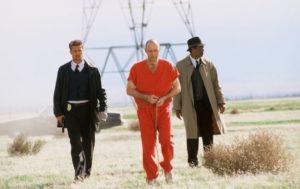Writing the Perfect Controlling Idea for Film and TV: The Ultimate Guide
A controlling idea is a foundation. Writing a screenplay is a lot like building a house. It is done piece by piece, each step builds upon another, and the final project must be structurally sound to last.
Also, just like a house, your screenplay needs a strong foundation before any other step can truly be complete.
This is where a controlling idea comes in.
Developing a tight and original controlling idea is an essential part of the writing process. For something so simple and short, it does a lot of the heavy work defining and guiding your story’s central focus.
Without it in mind, it’s all too easy for your script to become ineffective and aimless.
With that all said though, defining a controlling idea, knowing how best to use it, and figuring out how to write a great one is easier said than done. Read on to discover some of our essential tips.
Defining the Controlling Idea
Firstly, what is a controlling idea?
the controlling idea is a one-sentence statement of the story’s ultimate meaning expressed through the action and aesthetic emotion of the last act’s climax.
More specifically, a controlling idea:
- Is the main takeaway from the film or show, expressed through the action and aesthetic emotion of the last act’s climax.
- Encompasses the how and why of the change that takes place throughout the story.
- Essentially declares your ending from the very beginning and helps inform the steps you need to get there.
- Is made of two components: value and cause:
- This identifies the positive or negative charge of the story’s critical value at the last act’s climax. It also identifies the chief reason that this value has changed to its final state.
- Value and cause together expresses the core meaning of the story
Note: ‘Premise’ and ‘controlling idea’ are not completely interchangeable. While they are very closely related, premise deals heavier with “physical situations” while controlling idea deals more with thematic ones.
Starting at the End
One of the best and easiest ways to determine your controlling idea is to work backwards from your story’s end goal.
When doing this, it’s best to ask yourself “What do I want the end takeaway to be?”
You will need to take into consideration:
- What are you wanting to do practically? What’s going to happen in the setting, to the characters, etc?
- What do you want to do thematically? Is this a movie/show about family, love, violence, trust, fear, or something else?
- Do you want an overall message that is positive, negative, or neutral?
- Are you wanting the message to be painfully obvious, vague, or somewhere in between?
- What do characters learn from or add to the ending?
- How do you want the takeaway to be communicated with the audience?
Asking all of these questions will steer your end message in a certain direction and in turn, make figuring out the value of your project all the easier.
Go Big with the Value
Now that you have a general direction for where you need to go, you need to determine the value of your story. What’s the value? In simplified terms…
the value of your controlling idea is the primary positive or negative shift that occurs by the end of your story.
When deciding on this value, go big or go home. We are not looking for a small-scale claim, nor are we looking for an action-based or generally weak one either. Rather, you need your value to be a big, universal claim that will speak to the human experience.
A good starting point when formulating this is, of course, considering your movie or television show’s theme.
What exactly are you dealing with?
- Does your show or movie revolve around justice or injustice or perhaps are you more focused on love and hate?
- Are you exploring the concepts of greed and selflessness or change and stagnation?
- Are you exploring the role of family, relationships, pain, happiness, or the search for meaning?
Or maybe you’re looking at something else entirely. Either way, starting with large emotional themes sets you up on the right path. Then, all you need to do is determine what you want to say about this large emotional theme.
At the end of the day, what do you want the audience to take away or reflect on?
- Does justice or injustice prevail?
- Does love conquer all or not?
- Are our differences good or bad?
All of these are potentially great starting points that you could consider.
Finding the Why
Once you have your value, you still have the important job of figuring out the other half of your controlling idea: the cause.
The cause is basically the ‘how’ or ‘why’ behind your value. It essentially takes care of the practical reasons behind your claim and is crucial for your controlling idea.
Just a value and no cause is like a thesis statement with no evidence. As such, it’s important to give a compelling reason why your value/claim happens.
If you’ve already gone into your project with a cause in mind, this step should be easy. However, if you have not, there’s a kind of rule of thumb you can follow to acquire a good one. Often, a cause can be broken down into a few main types including:
- Cause of Character: Where a cause occurs due to the actions of a protagonist against an antagonizing force
- Traditional Cause/Effect: Where a cause logically follows the value.
- Value-Based: Where a cause occurs because it is seen as more morally superior or more natural than the antagonizing force (Eg. Love wins because love is stronger than hate).
While these are certainly not the only types you can use, they’re a great starting point if you’re stuck!
Regardless of what type you choose, always make sure it is a compelling cause that makes sense for your story and for your audience.
Don’t Over-Complicate
At the end of the day, your controlling idea should feel big and important, but it should also feel effortless and relatable. Don’t strain too hard to make something overly intellectual or complex!
The closer you can get to simple truths or experiences, the better. Why? Because the audience can always appreciate a message that gets to who we are as people.
- This is why messages about love, meaning, connection, and fear are always huge hits. They are timeless, relatable, and meaningful.
Your audience is looking for that. Even if they’re watching your movie or show mainly for entertainment, everyone always loves a good moral of the story they can put to use.
Additionally, an over-complicated controlling idea can put a real damper on your writing!
Remember, it is the foundation for everything else that is coming. If your foundation is unwieldy and too ambitious, then everything you build on top of it will be as well. Eventually, the Jenga tower always starts to lean if the base is off-kilter.
Even if your controlling idea is good, if it has too many moving parts, it will still make writing your script rather difficult.
You don’t want to constantly feel like you need to “live up” to your message. It will either overwhelm and paralyze you from actually writing or it will make your film feel disingenuous.
Controlling Idea Examples
Still unsure about writing your own controlling idea? Here are some great examples of outstanding controlling ideas.
Sometimes the best way to learn is by observing!
Thought of another film or show with a great controlling idea? Comment below on any other movies/shows and their controlling ideas you think should be added to the list!
- Se7en and Chinatown: “Injustice prevails because the antagonist is overwhelmingly ruthless and powerful”
- The Godfather: “A systemization of corruption yields a diminishing sense of guilt” OR “Family is sacred”
- Dirty Harry: “Justice triumphs because the protagonist is more violent than the criminals.”
- Columbo: “Justice is restored because the protagonist is cleverer than the criminal.”
- Death Wish: “Justice triumphs when citizens take the law into their own hands and kill the people who need killing.”
- In The Heat of the Night: “Justice is restored because a perceptive black outsider sees the truth of white perversion.”
- Groundhog Day: “Happiness fills our lives when we learn to love unconditionally.”
- Dangerous Liaisons: “Hatred destroys us when we fear the opposite sex.”
- What did you think of this article? Share it, Like it, give it a rating, and let us know your thoughts in the comments box further down…
- Struggling with a script? Story analysis is what we do, all day, every day…check out or range of services for writers & filmmakers here.
Get *ALL* our FREE Resources
Tackle the trickiest areas of screenwriting with our exclusive eBooks. Get all our FREE resources when you join 60,000 filmmakers on our mailing list!






Nicely worded statement. Essential for any good story.
Thanks Peter!
Is my outline in the best order—chronological order, spatial order, or order of importance—for me to present my main points? Will this order help me get my main point across?